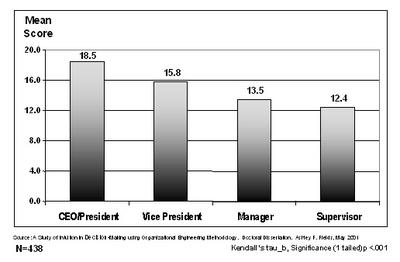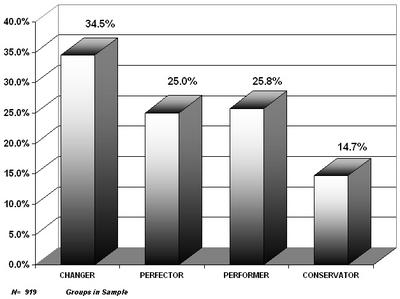SHORT-RUN LEADERSHIP BEHAVIOR
Dr. Ashley Fields’ 2001 Doctoral Dissertation investigated the “I Opt” strategic style preferences of leaders.

Using Professional Communications’ Summary database, Dr. Fields found that the Relational Innovator (RI) was the strategic style most characteristic of leaders. A portion of his findings are shown in Graphic 1.
Graphic 1
Relational Innovator (RI) Scores by Organizational Rank
Relational Innovator (RI) Scores by Organizational Rank
 (Click here to view entire dissertation in Acrobat)
(Click here to view entire dissertation in Acrobat)Dr. Fields' discovery was more important than just finding that the RI style dominated. He found a “stairstep” function—the higher the organizational level, the higher the level of the Relational Innovator (RI) style. This finding suggests:
Leadership development should focus on developing a
RI capacity among its pool of all future leaders at all levels.
RI capacity among its pool of all future leaders at all levels.
Another implication of the “stairstep” is that the optimal level of RI is not the same for every position. The levels of RI appropriate for a CEO is not the level that is optimal for a supervisor and vice versa. This means:
The central implication of the findings is that a "one size fits all" approach to leadership development is probably ill-advised. Leaders targeted toward sales management need a different approach than those targeted toward banking. To be fully effective:
Another implication is that normative models (models based on a survey of opinions of leaders in a specific area) probably incorporate a mixture of human information processing patterns and industry specific variables. This probably accounts for the 171,612 books on leadership currently available on Amazon (as of October 25, 2005). This suggests:
Both elements are important in leadership. Treating each separately makes teaching easier and learning more effective. Combining the two elements can create a tangle of permutations that can be hard to put into actual practice.
A final implication is that there is much more to leadership than indivdual skills. Leaders must work together if the goals of a firm are to be fully realized. Since leaders are not clones, it can be expected that the information-processing styles being used will clash with as well as complement each other.
Leadership developement should anticipate this condition. People typically believe that their "way is the right way." That is why they use it. They have to be shown that other strategies have value and can be meshed to create a whole greater than the sum of the parts. This suggests that:
This blog is not an attempt to lay out an academically definitive theory of leadership. It's intent is only to outline some of the obvious implications flowing from the data on actual teams functioning today in the "real world." If it stimulates the thinking of people involved in leadership development, it has served it’s purpose.
Leadership development will have to align its offerings
with the level of the people it is developing.
with the level of the people it is developing.
Dr. Fields’ findings are an important first step. The next step is to focus on the longer-term behaviors of leaders.
LONG-RUN LEADERSHIP BEHAVIOR
Most issues of significance involve a series of decisions. Even if the first decision yields to the RI approach, it is very unlikely that the next decision in sequence will succumb to the same strategy. This is where a person's secondary style comes into play.
A secondary style is the next most likely to be used where the primary style does not apply. The combination of the most and the next most used style will come to characterize behavior. This concept is captured in the "I Opt" variable called "Strategic Pattern."
Strategic patterns are combinations of behaviors connected by a commonality in either method (input) or mode (output) strategies. Patterns usually (but not always) combine a person's primary and secondary preferences. Table 2 defines the "I Opt" behavioral patterns.

I conducted a study to identify the strategic pattern most favored by leaders. Our Hierarchical Database contains information on 919 teams. Using this database it is possible to identify the strategic pattern (primary and secondary style) that most differentiates the leader from the remainder of the team. The results of this study are shown on Graphic 2.

Changer is the dominant pattern.
This finding suggests that the current social environment favors a strategic pattern based on innovation, speed, experimental implementation, and so on. The cost of this approach—suboptimal solutions, high failure rate, and organizational disruption -- does not appear high enough to offset the advantages of the strategy. The implication of this finding is:
The Changer Pattern is not a universal "good."
Not every leadership position favors the Changer pattern. Both the Perfector and Performer positions are also strongly represented. An examination of the database suggests that these patterns are probably functionally determined. For example, sales management seems to favor the Performer pattern (“Get it done!") while university level academicians lean toward Perfector ("Let's think it through"). The implication of this finding is:
The least represented pattern, Conservator, has its place.
This pattern seems to be found in areas where accuracy is more valuable than innovation. Applied science leaders as well as Certified Public Accountants show a greater representation of the Conservator pattern. These high accuracy areas can be vital to business success. The implication is:
GLOBAL IMPLICATIONS
LONG-RUN LEADERSHIP BEHAVIOR
Most issues of significance involve a series of decisions. Even if the first decision yields to the RI approach, it is very unlikely that the next decision in sequence will succumb to the same strategy. This is where a person's secondary style comes into play.
A secondary style is the next most likely to be used where the primary style does not apply. The combination of the most and the next most used style will come to characterize behavior. This concept is captured in the "I Opt" variable called "Strategic Pattern."
Strategic patterns are combinations of behaviors connected by a commonality in either method (input) or mode (output) strategies. Patterns usually (but not always) combine a person's primary and secondary preferences. Table 2 defines the "I Opt" behavioral patterns.

I conducted a study to identify the strategic pattern most favored by leaders. Our Hierarchical Database contains information on 919 teams. Using this database it is possible to identify the strategic pattern (primary and secondary style) that most differentiates the leader from the remainder of the team. The results of this study are shown on Graphic 2.
Graphic 2
Leadership Strategic Pattern Distribution in Teams
Leadership Strategic Pattern Distribution in Teams

Changer is the dominant pattern.
This finding suggests that the current social environment favors a strategic pattern based on innovation, speed, experimental implementation, and so on. The cost of this approach—suboptimal solutions, high failure rate, and organizational disruption -- does not appear high enough to offset the advantages of the strategy. The implication of this finding is:
It is not enough to focus exclusively on the RI (idea) capability.
A secondary RS (quick action) capacity must also be developed.
A secondary RS (quick action) capacity must also be developed.
The Changer Pattern is not a universal "good."
Not every leadership position favors the Changer pattern. Both the Perfector and Performer positions are also strongly represented. An examination of the database suggests that these patterns are probably functionally determined. For example, sales management seems to favor the Performer pattern (“Get it done!") while university level academicians lean toward Perfector ("Let's think it through"). The implication of this finding is:
Developing effective leadership is situational.
Leadership development must be sensistive to the leader's area.
Leadership development must be sensistive to the leader's area.
The least represented pattern, Conservator, has its place.
This pattern seems to be found in areas where accuracy is more valuable than innovation. Applied science leaders as well as Certified Public Accountants show a greater representation of the Conservator pattern. These high accuracy areas can be vital to business success. The implication is:
Leadership development must create a respect for different
leadership strategies. If everyone tries to be a Changer, the
organization will probably suffer.
leadership strategies. If everyone tries to be a Changer, the
organization will probably suffer.
GLOBAL IMPLICATIONS
The central implication of the findings is that a "one size fits all" approach to leadership development is probably ill-advised. Leaders targeted toward sales management need a different approach than those targeted toward banking. To be fully effective:
Leadership development must be sensitive
to the nature of the leader that it is trying to create.
to the nature of the leader that it is trying to create.
Another implication is that normative models (models based on a survey of opinions of leaders in a specific area) probably incorporate a mixture of human information processing patterns and industry specific variables. This probably accounts for the 171,612 books on leadership currently available on Amazon (as of October 25, 2005). This suggests:
Information processing preferences can be
treated separately from local variables.
treated separately from local variables.
Both elements are important in leadership. Treating each separately makes teaching easier and learning more effective. Combining the two elements can create a tangle of permutations that can be hard to put into actual practice.
A final implication is that there is much more to leadership than indivdual skills. Leaders must work together if the goals of a firm are to be fully realized. Since leaders are not clones, it can be expected that the information-processing styles being used will clash with as well as complement each other.
Leadership developement should anticipate this condition. People typically believe that their "way is the right way." That is why they use it. They have to be shown that other strategies have value and can be meshed to create a whole greater than the sum of the parts. This suggests that:
Leadership development efforts should include sessions
where the relative advantages and vulnerabilities
of each pattern are made visible.
where the relative advantages and vulnerabilities
of each pattern are made visible.
This blog is not an attempt to lay out an academically definitive theory of leadership. It's intent is only to outline some of the obvious implications flowing from the data on actual teams functioning today in the "real world." If it stimulates the thinking of people involved in leadership development, it has served it’s purpose.